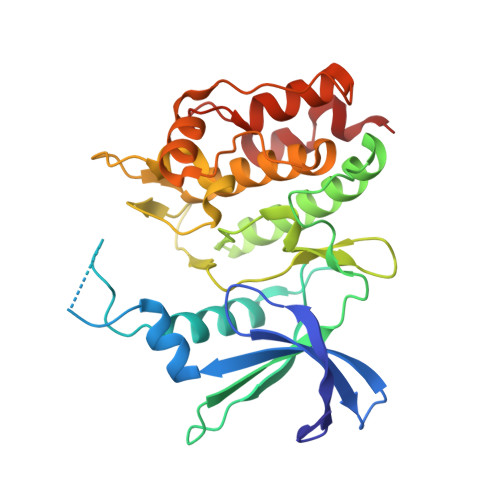Identification of Small Molecule Inhibitors and Ligand Directed Degraders of Calcium/Calmodulin Dependent Protein Kinase Kinase 1 and 2 (CaMKK1/2).
Chen, Y., Whitefield, B., Nevius, E., Hill, M., DelRosario, J., Sinitsyna, N., Shanmugasundaram, V., Mukherjee, D., Shi, L., Mayne, C.G., Rousseau, A.M., Bernard, S.M., Buenviaje, J., Khambatta, G., El Samin, M., Wallace, M., Nie, Z., Sivakumar, P., Hamann, L.G., McDonnell, D.P., D'Agostino, L.A.(2023) J Med Chem 66: 15750-15760
- PubMed: 38009718
- DOI: https://doi.org/10.1021/acs.jmedchem.3c01137
- Primary Citation of Related Structures:
8TUC - PubMed Abstract:
CaMKK2 signals through AMPK-dependent and AMPK-independent pathways to trigger cellular outputs including proliferation, differentiation, and migration, resulting in changes to metabolism, bone mass accrual, neuronal function, hematopoiesis, and immunity. CAMKK2 is upregulated in tumors including hepatocellular carcinoma, prostate, breast, and gastric cancer, and genetic deletion in myeloid cells results in increased antitumor immunity in several syngeneic models. Validation of the biological roles of CaMKK2 has relied on genetic deletion or small molecule inhibitors with activity against several biological targets. We sought to generate selective inhibitors and degraders to understand the biological impact of inhibiting catalytic activity and scaffolding and the potential therapeutic benefits of targeting CaMKK2. We report herein selective, ligand-efficient inhibitors and ligand-directed degraders of CaMKK2 that were used to probe immune and tumor intrinsic biology. These molecules provide two distinct strategies for ablating CaMKK2 signaling in vitro and in vivo.
Organizational Affiliation:
Bristol Myers Squibb, 10300 Campus Point Drive, San Diego, California 92121, United States.

















